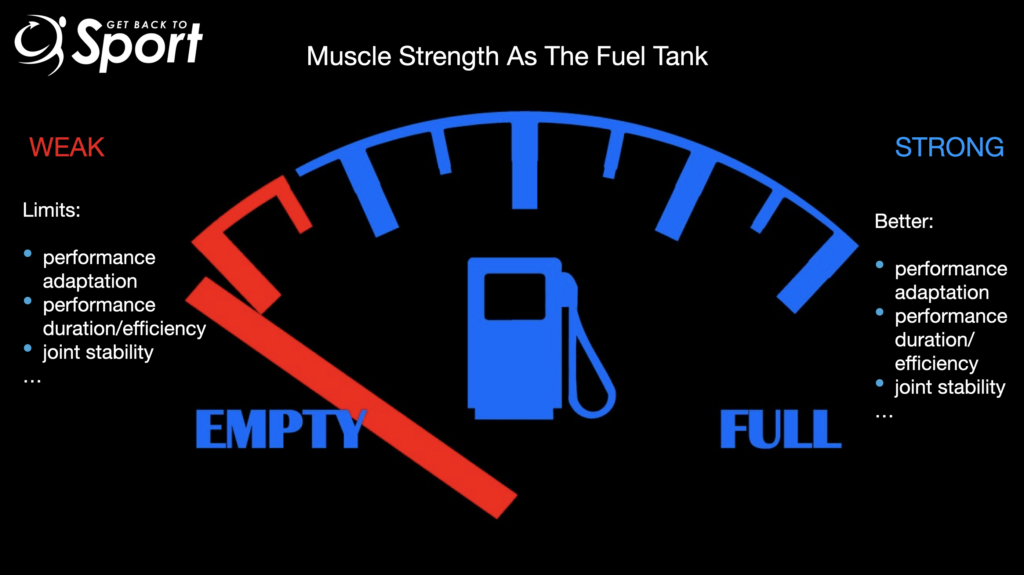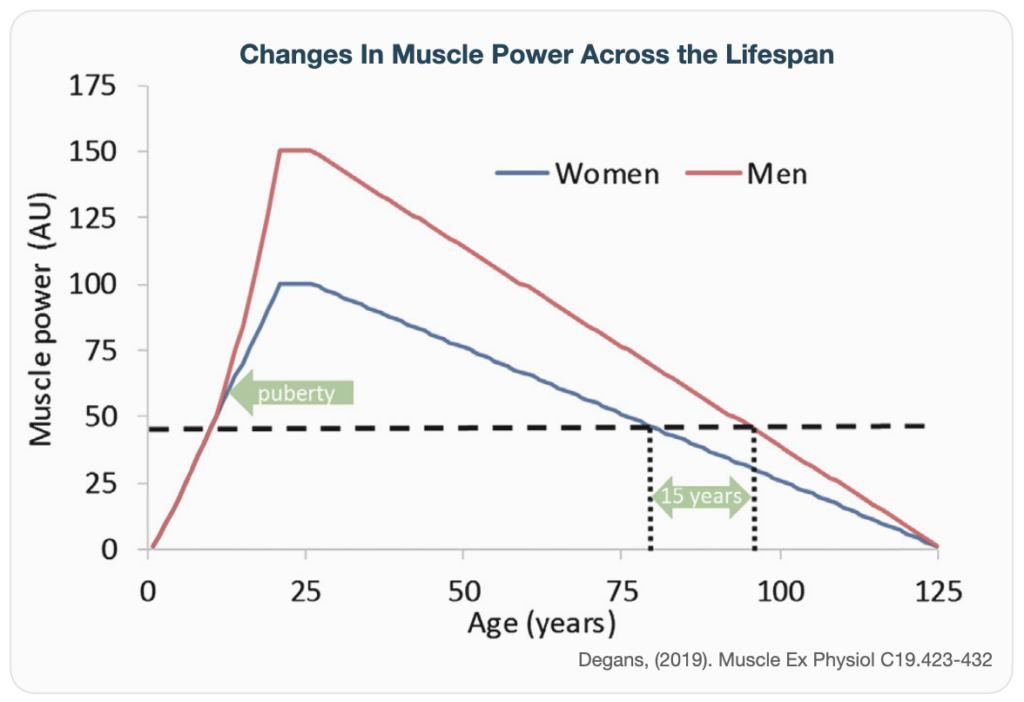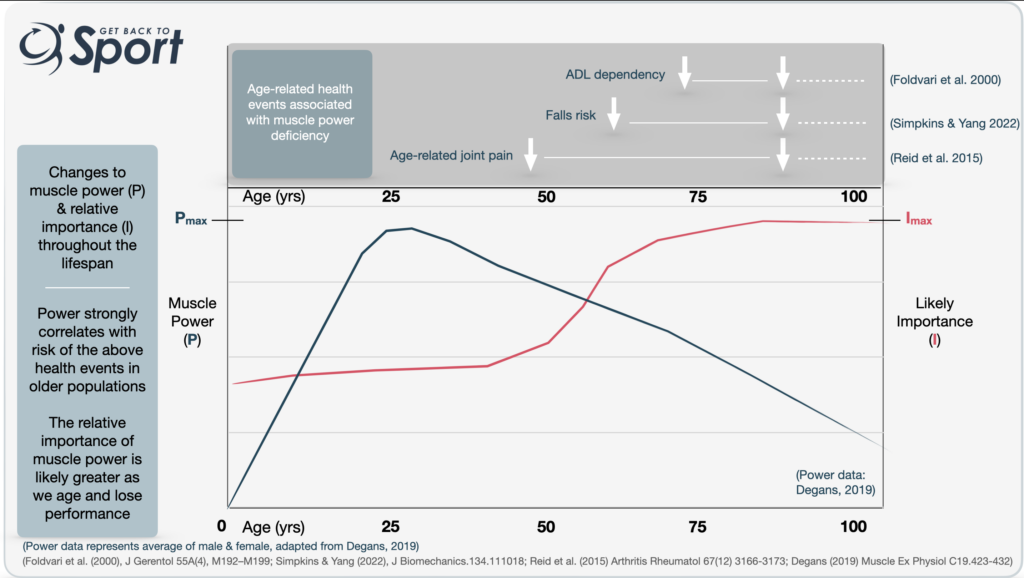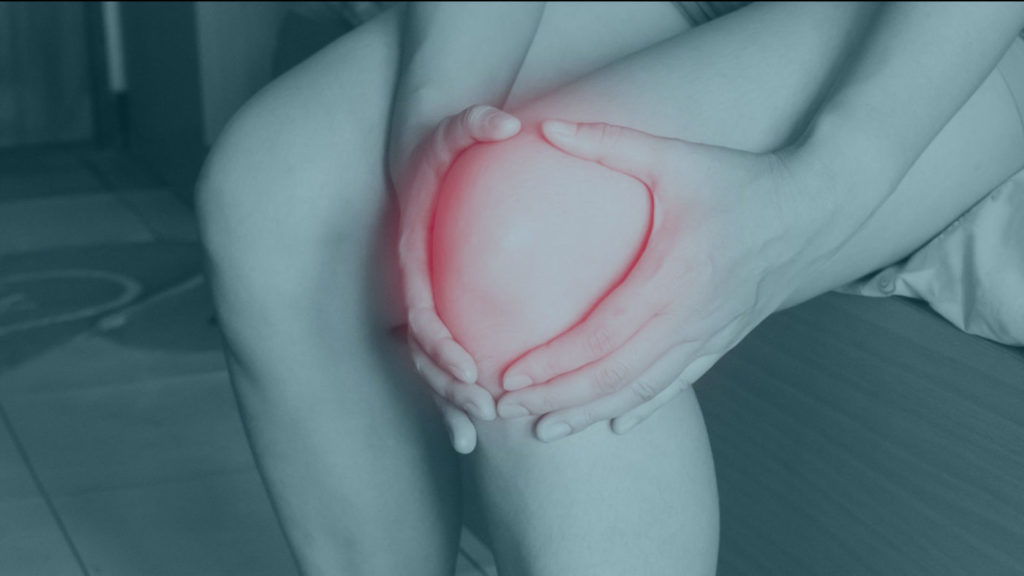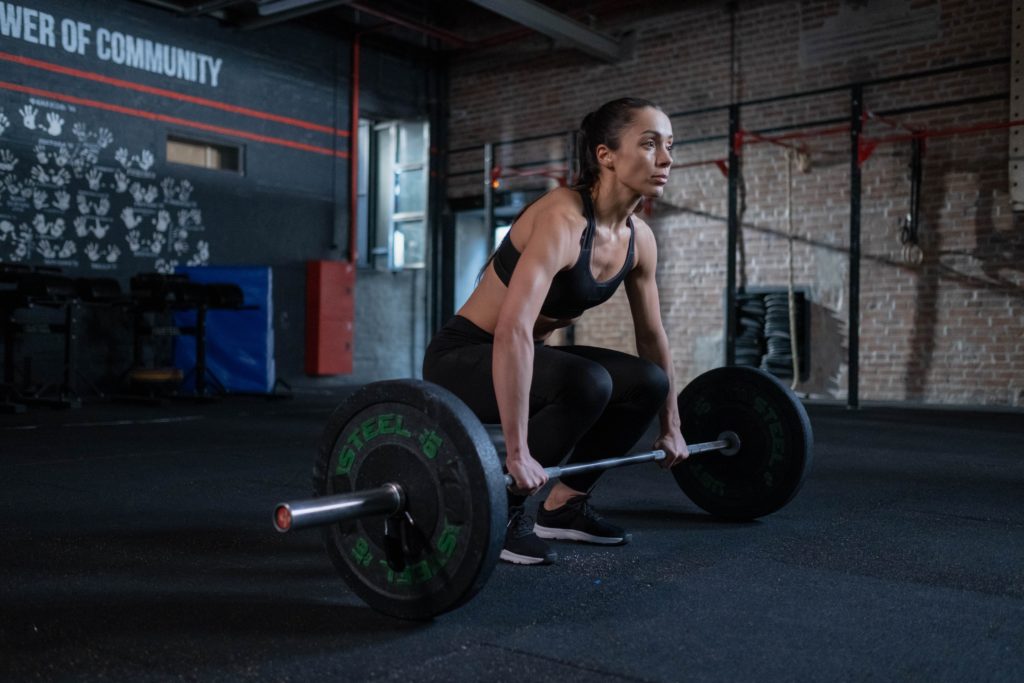Hi and welcome to this first in a series of posts on muscle power. Here we’re going to consider muscle power for successful ageing – is muscle power important for older populations? I talk a lot about strength (you may have noticed), but power, or the ability to express force quickly may be just as critical to a healthy ageing process.
The Importance of Muscle Power
To kick off, let me say that I think that the relative importance of muscle power increases as we age, commensurate with its loss. Exploring muscle power for successful aging means that we’re going to consider if this performance metric, often associated with sports performance, is important to mitigate the risk of age-related MSK health events. Below is a figure that illustrates the changes in muscle power performance across the lifespan and some of the MSK age-related health events that occur in later life that have been associated with muscle power. The red line maps the corresponding likely importance of muscle power over the lifespan.

Muscle power, or lack thereof is associated with a number of age-related health events, such as OA (osteoarthritis)-related joint pain, falls risk and ADL (activities of daily living) dependency. Below we’ll explore the evidence base for this and begin to understand that muscle power and power-based rehab and training isn’t applicable to athletes only.
What is muscle power?
Okay a quick reminder. We’ve covered muscle power and rate of force development in detail before (here). Save going into great detail again, let’s simplify to power to the ability to produce muscle force quickly, or indeed explosively.
We need a decent amount of muscle strength to start with (see fuel in the tank analogy here). If standing up out of a chair represents a maximal strength effort, training to produce force quickly (with low external overload) is likely to be a futile exercise. Greater baseline levels of muscle force i.e. strength are critical for a number of reasons, again see figure below.
Loss of power over the lifetime
Just like other elements of performance and function, age-related changes are observed with muscle power. Initially as we grow and mature, power performance increases, then after a time it starts to decline. See the figure below from Degans et al. (2019).
Remember, these data represent the average population, so we’re not talking about the very ill or the very elite. We can see a difference between men and women and in decay (males showing a more accelerated decline), however, when normalised to body mass the relative level of performance and decay rate is very similar. See below for examples in athletic populations.
Why is power Important?
What’s notable is that at some point individuals will reach a disability threshold, represented by the dashed line in the figure above. This disability threshold is discussed in the context of maximal muscle strength too. Because males are starting from greater absolute levels of performance, they tend to reach this threshold, whether that be describing strength or power capabilities, later compared to females.
Muscle Power and ADLs
Loss of muscle power correlates with disability. Specifically we see that knee extensor peak power is predictive of performance on activities of daily living such as chair rise performance, stair climbing and gait speed. Foldvari et al. (2000) reported that peak muscle power was slightly superior (r = 0.47) than muscle strength (r = 0.45) in predicting functional status in elderly community dwelling women; that is to say that muscle power was a strong predictor of self-reported functional status in elderly women, independently accounting for approximately 23% of the variance. Others have reported similar findings, see Reid and Fielding for a nice review of this topic.
Muscle Power and Falls Risk
Falls generally occur when an individual loses balance following a slip, trip or perturbation. The muscles of the lower limbs in particular are integral the termination of a fall following loss of balance. Performance characteristics including strength (having ‘enough’ muscle force) and power (producing force quickly) are correlated with falls risk. The importance of strength in response to experimentally-induced slips and trips has been demonstrated by many; those with low strength fall due to the inability to support the body during the reactive stepping. But there’s also a contraction velocity issue here.
Falls, as with many injuries, occur rapidly following perturbation and there’s a growing body of evidence to suggest that muscle power may have greater association and predictive association with falls risk. A recent study by Simpkins & Yang (2022) assessed 94 older adults (mean age 72 years) on isometric strength and pragmatic test of power – a timed test of 5 sit-to-stands alongside self-reported falls history. The data suggests that leg muscle power is more predictive of everyday living falls than strength in community-dwelling older adults. They even calculated a cut-off value to discriminate fallers and non- fallers; this was 1.3 W/(kg × m) and 12 seconds.
Muscle Power & Joint Pain
We see an association too with muscle power and age-related joint pain. Several studies have demonstrated an association between muscle power and osteoarthritic knee pain and function. Reid et al (2015) investigated the relationships between lower extremity muscle strength, power and perceived disease severity in a large study population (n = 190) with established knee OA. They found that power but not strength was significantly associated with the experience of knee pain (r = -0.17, p<0.02). We have to note here that whist the association was significant, the association (r = -0.17) is fairly weak.
Accettura et al. in the same year yet in a smaller sample and using a different assessment of power, examined the extent to which 2-year changes in mobility performances were predicted by baseline strength, power, pain, and self-efficacy. After adjusting for covariates (such as BMI, self-efficacy), knee extensor power power explained up to 6%, 8%, and 3% more of the total variance of scores from the 6 Minute Walk Test, timed stair ascent task, and timed stair descent task, respectively, compared with extensor strength. The r2 values, if you’re interested for 6 Minute Walk Test, timed stair ascent task, and timed stair descent task were 0.39 vs 0.37; 0.60 vs. 0.54 and 0.47 vs 0.43 for power vs strength, respectively.
These associations are far greater than in the study by Reid, differences potentially explained by methodical approach, smaller sample and with good baseline levels of function. Nevertheless, evidence is emerging that power may play a role in joint pain
Summary: Muscle power for successful ageing
So what can we say about muscle power for successful ageing? Well, muscle contractile properties are important for a healthy life and likely relative importance becomes greater as we age, commensurate with its loss. What’s encouraging, however, is that we can improve muscle power no matter what age. Search the literature and you’ll see scores of examples. If you want to know more and importantly, how to train power properly, and specifically for rehab check out my online course below.
The Only Online Power Course for Rehab Professionals
References
- Degans et al. (2019). Human Ageing: Impact on Muscle Force and Power. Muscle and Exercise Physiology LINK
- Foldvari et al. (2000). Association of Muscle Power With Functional Status in Community-Dwelling Elderly Women. J Gerentol 55A(4), M192–M199 LINK abstract
- Simpkins & Yan (2022). Muscle power is more important than strength in preventing falls in community-dwelling older adults. J Biomechanics. 134 111018. LINK
- Accettura et al (2015). Knee Extensor Power Relates to Mobility Performance in People With Knee Osteoarthritis: Cross-Sectional Analysis. Phys Ther. 2015 Jul; 95(7): 989–995 LINK.
